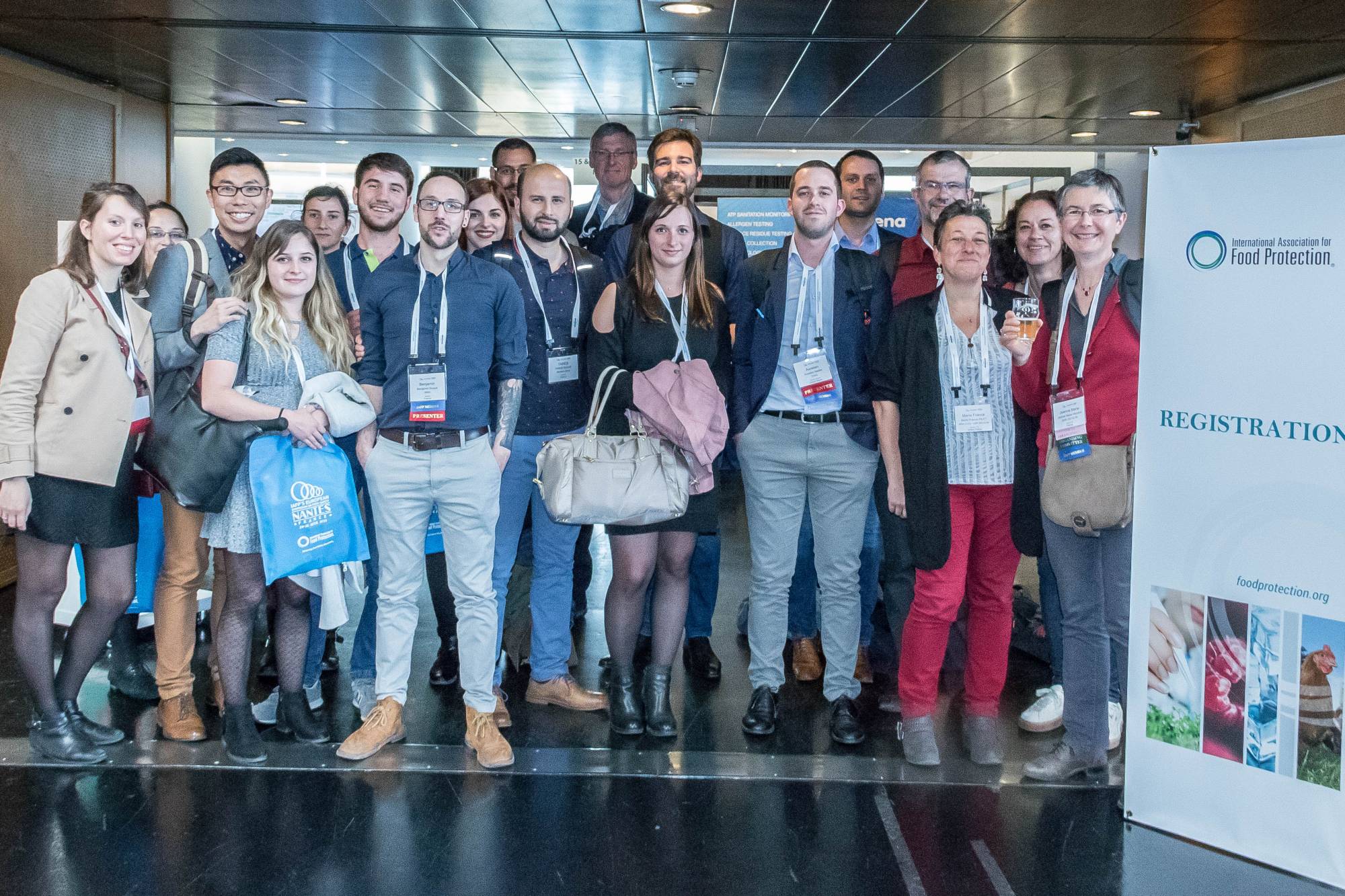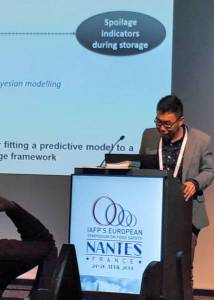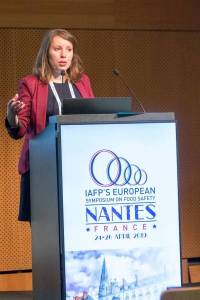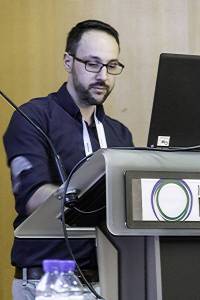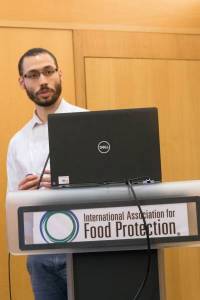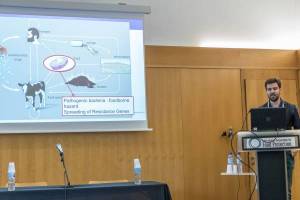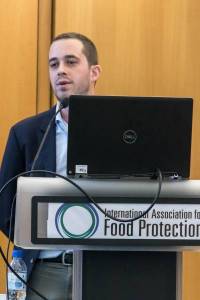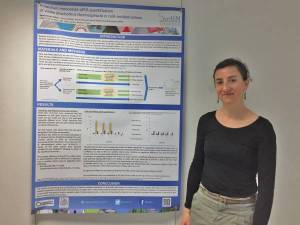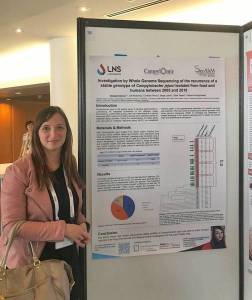The main European actors of food safety (agencies, research laboratories and food companies) at Nantes from the 24th to the 26th of april
The IAFP European Symposium is an international conference on food safety organized by the International Association for Food Protection (IAFP). The conference brought together more than 400 participants from around the world (17 countries represented) from 24th to 26th April 2019 at the Cité des Congrès in Nantes.
This congress was supported by SECALIM, of which two members: Jeanne-Marie Membré and Nabila Haddad, participated in the organizing committee of the conference and the local committee.
The congress included 15 symposia, 9 technical sessions and 3 round tables covering many areas of food safety: hygiene control including consumer practices, standards in food microbiology, detection and control of pathogens including Campylobacter, recent methods of identifying emerging risks, food spoilage, risk assessment and risk / benefit assessment, etc.
UMR SECALIM participated actively in this conference. No less than twenty of its members were present at the scientific days.
A total of four symposia were organized by SECALIM:
• Network analysis to better describe the functions and dynamics of microbial food ecosystems1
• New approaches to modeling the microbiological alteration of foods2
• The challenges of accurately detecting and quantifying Campylobacter3
• Ongoing research activities on the risk-benefit assessment of food4
The symposia principle is to illustrate the scientific advances around a common theme, with the interventions of three scientists from different laboratories / companies and countries. As part of these symposia, three of our doctoral students, Juliana de Oliveira Mota5, Ngoc-Du Luong6 and Benjamin Duqué7 were able to communicate their research results.
|
|
|
Ngoc-Du Luong, presented an innovative method of spoilage modeling by a Bayeasian approach6 | Juliana de Oliveira Mota, presented risk-benefit assessment of read meat5 |
|
| Benjamin Duqué, explains how better predict the behaviour of Campylobacter jejuni by the use of gene expression biomarkers7 |
Five oral communications were also presented in the technical sessions.
|
| Vincent Tesson8, in post-doctoral position in SECALIM, presented a critical analysis of microbiological risk assessment models for meat. |
Emmanuel Jaffrès9, lecturer at SECALIM, presented the PhD work of Nassima Illikoud, on the mechanisms of microbial spoilage due to Brochothrix thermosphacta in seafood and meat products. |
|
|
| Nicolas Helsens10, PhD student at SECALIM, exposed his studies on the bacterial resistome in rainbow trout fillets. |
Aurélien Maillet11, PhD student at SECALIM, funded by Biofortis, described the analysis of contamination of the factory environmental contamination in smoked salmon industrial plant. |
|
At last, another oral communication proposed by Géraldine Boué, lecturer at SECALIM enabled to present the advances in risk-benefit assessment in food in the framework of the European project RiskBenefit4EU12.
Fours posters were also displayed13-16 .
Agnès Bouju-Albert15, technician at SECALIM, presented a method of quantification of viable cells of Brochothrix thermosphacta |
|
|
| Morgane Nennig16, phD student at SECALIM, in co-supervision with the Luxembourg National Laboratory for Health, presents her poster on the stability of genotypes of Campylobacter jejuni from human and food isolates by Whole Genome Sequencing (WGS) |
This unmissable conference was an opportunity for young scientists to present their work and for seniors to consolidate their existing collaborations or to open new ones.
References
1. Network Analysis to Better Decipher Functions and Dynamics of Food Microbial Ecosystems,
Symposium organisé par Sandrine Guillou, chercheur à SECALIM
2. Novel Modelling Approaches of Microbiological Spoilage in Food,
Symposium organisé par Sandrine Guillou et Louis Coroller, de l’Université Bretagne Ouest, Quimper
3. Challenges in Campylobacter Detection and Accurate Quantification,
Symposium organisé par Nabila Haddad, maître de conférence à SECALIM et Hedy den Besten, de l’Université de Wageningen
4. Ongoing Research Activities in Risk-Benefit Assessment of Food,
Symposium organisé par Jeanne-Marie Membré, chercheur à SECALIM
5. Risks and Benefits Associated with Red Meat Consumption in France
Juliana De Oliveira Mota1, Patrick Tounian2, Géraldine Boué1, Fabrice Pierre3, Sandrine Guillou1, Jeanne Marie Membré1
1 SECALIM, INRA, Oniris, Université Bretagne Loire, 44307, Nantes, France
2 Service de nutrition et gastroentérologie pédiatriques, hôpital Trousseau, 26, avenue du Dr Arnold-Netter, 75012 Paris, France
3 INRA, ToxAlim (Research Centre in Food Toxicology), Université de Toulouse, INRA, ENVT, INP-Purpan, UPS, Toulouse, France Risks and Benefits Associated with Red Meat Consumption in France
6. Prediction of Spoilage Occurrence in French Fresh Poultry Sausages: Potential Role of Potassium Lactate and Modified Atmosphere Packaging
Ngoc-Du Luong1, Louis Coroller2, Jeanne-Marie Membré1, Sandrine Guillou1 and the REDLOSSES Consortium3.
1SECALIM, INRA, ONIRIS, Université Bretagne Loire, Route de Gachet, CS 40706, F-44307 Nantes, France
2 Université de Brest, Laboratoire Universitaire de Biodiversité et Ecologie Microbienne, UMT Alter’ix, F-29334 Quimper, FRANCE.
3 IFIP: C. Feurer, B. Frémaux, S. Jeuge; INRA-AgroParisTech, UMR1319-Micalis: S. Chaillou, M.-C. Champomier-Vergès, S. Poirier; Université de Brest, LUBEM: N. Desriac; Aérial: M.-H. Desmonts, E. Hamon, D. Werner; Itavi: P. Magdelaine; INRA-Université Paris-Saclay, UR1404-MaIAGE: V. Loux, O. Rué; Université de Liège: E. Cauchie, G. Daube; SECALIM, INRA, ONIRIS: E. Jaffrès, C. Magras, M. Zagorec.
7. The Survival of Campylobacter in the Food Chain, or How to Enhance the Robustness of the Model Prediction Using Molecular Markers
Benjamin Duqué1, Nabila Haddad1, Sandrine Rezé1, Albert Rossero1, Jeanne-Marie Membré1, Sandrine Guillou1 and the Biomics consortium2
1 SECALIM, INRA, Oniris, Université Bretagne Loire, Nantes, 44307, France
2 UBO EA3882-Lubem - UMT14.01 SPORE RISK, Quimper, France: Noémie Desriac, Lamia Belkadi, Louis Coroller; SECALIM, INRA, Oniris, Université Bretagne Loire, Nantes, 44307, France : Nabila Haddad, Jeanne-Marie Membré; ADRIA Food Technology Institute - UMT14.01 SPORE RISK: Florence Postollec
8. Critical Analysis of QMRA for Meats: What Do We Do Next?
Vincent Tesson1, Michel Federighi1, Enda Cummins2, Sandrine Guillou1, Jeanne-Marie Membre1 and Géraldine Boué1
1 SECALIM, INRA / ONIRIS, Nantes, France,
2 UCD School of Biosystems and Food Engineering, Dublin, Ireland
9. Characterization of Meat and Seafood Spoilage Mechanisms by Brochothrix thermosphacta
Nassima Illikoud1, Marie-France Pilet1, Emmanuel Jaffrès2 and Monique Zagorec1
1 SECALIM, INRA, Oniris, Université Bretagne Loire, 44307, Nantes, France, NANTES, France,
2 SECALIM, INRA, Oniris, Université Bretagne Loire, Nantes, France
10. The Antibiotic Resistome of Farmed Rainbow Trout Filets Using Smartchip Real-time PCR
Nicolas Helsens1, Ségolène Calvez2, Agnès Bouju-Albert1, Albert Rossero1, Hervé Prévost1 and Catherine Magras1
1 SECALIM, INRA, Oniris, Université Bretagne Loire, Nantes, France
2 BIOEPAR, INRA, Oniris, Nantes, France
11. Residential Surface Bacteria Mapping in a Cold-Smoked Salmon Processing Environment
Aurelien Maillet1, Agnès Bouju-Albert1, Steven Roblin2, Pauline Vaissié2, Sebastien Leuillet2, Xavier Dousset1, Emmanuel Jaffrès1, Jerome Combrisson2 and Herve Prévost1
1 UMR 1014 SECALIM, UBL, INRA, Oniris, Nantes, France
2 Biofortis Mérieux NutriSciences, Nantes, France
12. Risk Benefit Assessment of Foods: Lessons Learned from a Capacity Building Experience Under the RiskBenefit4EU Project
Géraldine Boué1, Paula Alvito2, Roberto Brazão2, Paulo Carmona3, Lea Jakobsen4, Carla Lopes5, Carla Martins2, Jeanne-Marie Membre1, Sarogini Monteiro6, Pedro Nabais3, Sofie Theresa Thomsen4, Duarte Torres5, Silvia Viegas2, Sara Pires4 and Ricardo Assunção2
1 Secalim, INRA / ONIRIS, Nantes, France
2 INSA, Lisbon, Portugal
3 ASAE, Lisbon, Portugal
4 Division of Diet, Disease Prevention and Toxicology, National Food Institute, Technical University of Denmark (DTU), Kgs. Lyngby, Denmark
5 University of Porto, Porto, Portugal
6 ASAE, Porto, Portugal
13. Partnering to Strengthen the Risk-Benefit Assessment within EU Using a Holistic Approach
Jeanne-Marie Membre1, Lea Sletting Jakobsen2, Sara Pires3, Géraldine Boué1, Ricardo Abreu de Assunçao4 and Paula Alvito4
1 SECALIM, INRA / ONIRIS, Nantes, France
2 Technical University of Denmark - DTU, Lyngby, Denmark
3 Division of Diet, Disease Prevention and Toxicology, National Food Institute, Technical University of Denmark (DTU), Kgs. Lyngby, Denmark
4 INSA, Lisbon, Portugal
14. Requirements and Guidelines for Conducting Challenge Tests of Food and Feed Products
Hélène Bergis1, Gail Betts2, Rachel Binet3, Patrick Bird4, Sara Bover-Cid5, Frederique Cantergiani6, Louis Coroller7, Heidy Den Besten8, Mariem Ellouze9, Elisa Goffredo10, Gretchen Gutierrez11, Véronique Huchet12, Paul in 't Veld13, Luigi Lanni14, Yvan Le Marc12, Jeanne-Marie Membre15, Elisabeth Payeux16, Stella Planchon17, Florence Postollec18, Valérie Stahl19, Agnes Tan20, Stéphanie Tiprez21 and Pamela Wilger22
1 ANSES, Maisons-Alfort, France
2 Campden BRI, Chipping Campden, United Kingdom
3 U.S. Food and Drug Administration, College Park, MD
4 Q Laboratories, Inc., Cincinnati, OH
5 IRTA. Food Safety Programme, Monells, Spain
6 Nestlé Research Center, Lausanne, Switzerland
7 University of Brest- UMT 14.01 SPORE RISK, Brest, France
8 Wageningen University, Wageningen, Netherlands
9 Nestlé Research Centre, Lausanne, Switzerland
10 Istituto Zooprofilattico Sperimentale della Puglia e Basilicata, Foggia, Italy
11 Northland Laboratories, Mount Prospect, IL,
12 ADRIA Food Technology Institute - UMT14.01 SPORE RISK, Quimper, France,
13 NVWA, Utrecht, Netherlands,
14 Istituto Zooprofilattico Sperimentale del Lazio e della Toscana, Roma, Italy
15 SECALIM, INRA / ONIRIS, Nantes, France
16 CTCPA, avignon, France
17 CTCPA, Avignon, France
18 ADRIA - UMT ACTIA19.03 ALTER’iX, Quimper, France
19 AERIAL, Illkirch, France
20 Consultant, Donvale, Australia
21 AFNOR, Paris, France
22 Cargill, Inc., Wayzata, MN
15. Propidium Monoazide qPCR Quantification of Viable Brochothrix Thermosphacta in Cold-Smoked Salmon
Agnès Bouju-Albert, Sabrina Saltaji, Xavier Dousset, Hervé Prévost and Emmanuel Jaffrès, UMR 1014 SECALIM, UBL, INRA, Oniris, Nantes, France
16. Investigation By Whole Genome Sequencing of the Recurrence of a Stable Genotype of C. jejuni Isolated from Food and Humans between 2005 and 2018
Morgane Nennig1, Joël Mossong1, Christian Penny2, Serge Losch3, Odile Tresse4 and Catherine Ragimbeau1
1 National Health Laboratory, Dudelange, Luxembourg
2 Luxembourg Institute of Science and Technology, Belvaux, Luxembourg
3 Laboratory of Veterinary Medecine, Dudelange, Luxembourg
4 SECALIM, INRA, Oniris, Université Bretagne Loire, NANTES, France


